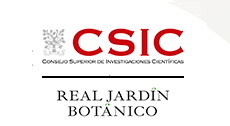Scientific Area
Abstract Detail
Nº613/1049 - Inter- and intraspecific variability in leaf minimum conductance (gmin) in vascular plant species across five biomes
Format: ORAL
Authors
Marc Carriqu1,2,Faustino Rubio3,Mara Ancn4,Ismael Aranda2,Daniela Aros-Mualin5,Unai Artetxe6,Manuel Ayuso7,ngel Barn-Sola3,Ignacio Buesa8,F. Javier Cano2,Miquel Cap9,Carles Cardona10,11,Jaume Company1,Mara del Rey2,Raquel Esteban6,Antoni Josep Far1,Beatriz Fernndez-Marn6,Jaume Flexas1,Luis Flor1,Angie L. Gmez12,J. Ignacio Garca-Plazaola6,Lloren Gibanel1,Roman Gmr5,M. Teresa Gmez-Sagasti6,Javier Gulas1,Virginia Hernandez-Santana13,Antonio Hernndez6,Laia Jen14,Rafael G. Lacalle6,Ana Lpez-Ballesteros15,16,Rubn Martin-Snchez15,Enrique Mateos-Naranjo17,David Medel3,Pere Miquel Mir-Rossell1,11,Jos Carlos Miranda3,Melanie Morales14,Lluna Morcillo18,Sergi Munn-Bosch14,Miquel Nadal15,Jorge Pallars3,Alicia V. Perera-Castro19,Alfonso Perez-Martin13,Javier Pichaco13,Marta Pint-Marijuan14,Rocio Ploschuk20,Joan Pons1,Jess Rodrguez-Calcerrada3,Celia M. Rodrguez-Domnguez13,J. Salvador Rubio-Asensio21,Lorena Ruiz de Larrinaga6,Roberto L. Salomn3,Jaime Sebastian-Azcona13,David Soba22,Guillermo Toro23,Alberto Vilagrosa18,24,Sabina Villadangos14,Rosana Lpez3
Affiliations
1 Grup de recerca en Biologia de les Plantes en Condicions Mediterrànies, Departament de Biologia, Universitat de les Illes Balears, Institut d'Investigacions Agroambientals i d'Economia de l'Aigua (INAGEA), 07122 Palma, Illes Balears, Spain
2 Instituto de Ciencias Forestales (ICIFOR-INIA), CSIC, Carretera de La Coruña k.m. 7.5, 28040, Madrid, Spain
3 Grupo de Investigación FORESCENT, Departamento de Sistemas y Recursos Naturales, Universidad Politécnica de Madrid.
4 Instituto de Agrobiotecnología (IDAB), Consejo Superior de Investigaciones Científicas (CSIC)-Gobierno de Navarra, Avenida Pamplona 123, 31192 Mutilva, Spain.
5 Department of Systematics and Evolutionary Botany, University of Zurich, 8008 Zurich, Switzerland.
6 “Group of Biodiversity, Ecosystem Services and Ecophysiology of Stress and Pollution in Plants” (BEZ-EKOFISKO), Department of Plant Biology and Ecology, Faculty of Science and Technology, University of the Basque Country (UPV/EHU), P.O. Box 644, 48080 Bilbao, Spain
7 Centro de Investigação de Montanha (CIMO), Instituto Politécnico de Bragança, Campus de Santa Apolónia, 5300-253 Bragança, Portugal.
8 Centro de Investigación de la Desertificación (CIDE), Consejo Superior de Investigaciones Científicas (CSIC-UV-GV), Ctra. CV-315, km 10,7, 46113-Moncada, Valencia, Spain.
9 Plant & Animal Ecology Lab. Centro para la Conservación de la Biodiversidad y el Desarrollo Sostenible. Departamento de Sistemas y Recursos Naturales, Universidad Politécnica de Madrid.
10 Centre Forestal de les Illes Balears (CEFOR-Menut), Institut Balear de la Natura (IBANAT), C/Gremi de Corredors 10 (Polígon Son Rossinyol), 07009, Palma, Spain
11 Interdisciplinary Ecology Group. Department of Biology, University of the Balearic Islands (UIB), Ctra. Valldemossa, Km 7,5. 07122, Palma, Spain
12 Department of Agronomy, Biotechnology and Food Science, Public University of Navarre (UPNA), 31006, Pamplona – Spain
13 Irrigation and Ecophysiology Group. Instituto de Recursos Naturales y Agrobiología (IRNAS), Consejo Superior de Investigaciones Científicas (CSIC), Avda Reina Mercedes, 41012 Seville, Spain
14 Departament de Biologia Evolutiva, Ecologia i Ciències Ambientals, Institut de Recerca en Biodiversitat, Universitat de Barcelona, Avinguda Diagonal 643, 08028 Barcelona, Spain.
15 Departamento de Sistemas Agrícolas, Forestales y Medio Ambiente, Centro de Investigación y Tecnología Agroalimentaria de Aragón (CITA), Avda. Montañana 930, 50059, Zaragoza, Spain
16 AgriFood Institute of Aragon – IA2 (CITA-University of Zaragoza), Zaragoza, Spain
17 Departamento de Biología Vegetal y Ecología, Facultad de Biología, Universidad de Sevilla, 1095, 41080, Sevilla, Spain
18 Mediterranean Center for Environmental Studies (CEAM Foundation). Joint Research Unit University of Alicante-CEAM, University of Alicante, 03690, Sant Vicent del Raspeig, Alacant, Spain
19 Departamento de Botánica, Ecología y Fisiología Vegetal, Universidad de La Laguna, 38206 La Laguna, Spain
20 Department of Agricultural and Forest Sciences and Engineering, University of Lleida-AGROTECNIO-CERCA Center, Av. Rovira Roure 191, 25198 Lleida, Spain
21 Departamento de riego. Centro de Edafología y Biología Aplicada del Segura. Consejo Superior de Investigaciones Científicas (CEBAS-CSIC). Campus de Espinardo, Espinardo 30100. Murcia. Spain.
22 Institute for Multidisciplinary Research in Applied Biology (IMAB), Universidad Pública de Navarra (UPNa), Campus Arrosadia, 31006 Pamplona, Spain
23 Centro de Estudios Avanzados en Fruticultura (CEAF), Las Parcelas 882, Rancagua, Chile.
24 Department of Ecology, University of Alicante, 03690, Sant Vicent del Raspeig, Alicante, Spain
Abstract
Leaf minimum conductance (gmin) represents the vapor diffusion conductance through the surface with closed stomata, encompassing cuticle and leaky stomata. It stands as a critical functional trait defining the dehydration rate after stomatal closure and its capacity to overcome long-lasting droughts and heatwaves. While other traits related to drought resistance (e.g., wilting point, embolism vulnerability) are known to vary with climate, the climate-dependent variation in gmin remains poorly understood, despite being recognized to display significant interspecific variability and plasticity to growth conditions.
Our study encompasses a diverse array of over 300 species growing under natural conditions, including angiosperms, gymnosperms and pteridophytes, as well as various growth formsfrom trees to herbsand leaf habits. To capture the interspecific variability and plasticity in gmin, we sampled plants from more than 50 locations spanning a steep mean annual temperature and precipitation gradient in Europe, ranging from 2.4 to 19.6 C, and 250 to 2200 mm, respectively. Sampling was conducted on current-year, sun-adapted leaves during the summer of 2023. Measurements also included leaf dimensions, stomata distribution, trichome presence, and leaf dry mass per area. This broad sampling allows to explore the extent of gmin variability and its potential correlations with climatic conditions across five biomes in a large spectrum of plant diversity.
In order to explore intraspecific variability, we selected four widely distributed species representing different ecological strategiesQuercus ilex (evergreen angiosperm), Ailanthus altissima (deciduous angiosperm), Pinus halepensis (evergreen gymnosperm), and Pteridium aquilinum (fern) and measured them in over 10 locations.
Results showed a strong intra- and inter-specific variability in gmin, as well as significant plasticity.This study provides valuable insights into the adaptive responses of plants to climate,enhancing our understanding of the functional significance of gmin in thecontext of climatechange adaptation.




